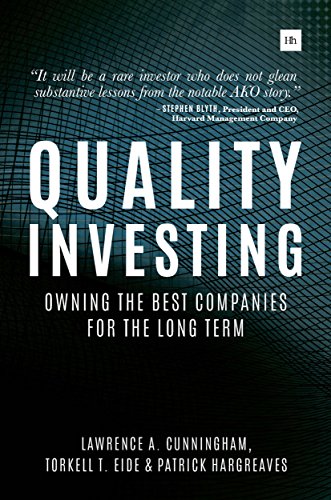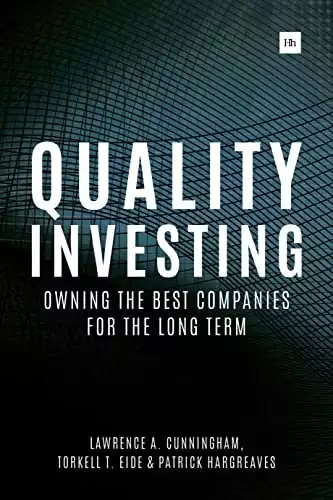Overview : Quality Investing: Owning the Best Companies for the Long Term
-
Book Title: Quality Investing: Owning the Best Companies for the Long Term
-
Author: Lawrence A. Cunningham, Torkell T. Eide, and Patrick Hargreaves
-
Publication Date:March 2016
-
Rating: 4.5
-
price: $33.69
-
Pages: 320
About the Author
An insightful guide from an experienced investor, Quality Investing provides timeless principles for identifying and investing in high-quality businesses. Written by a seasoned financial professional, it distills decades of expertise into actionable strategies for long-term success.
Introduction
Quality Investing: Owning the Best Companies for the Long Term, authored by LawrenceIn the ever-evolving world of finance and investing, few books manage to stand the test of time while offering timeless wisdom. "Quality Investing: Owning the Best Companies for the Long Term" by Lawrence A. Cunningham, Torkell T. Eide, and Patrick Hargreaves is one such rare gem. This comprehensive review delves into the core principles of quality investing, exploring how this approach can revolutionize your portfolio management strategy.
Book Summary and Author Credentials
Published in 2016, "Quality Investing" has quickly become a cornerstone text for investors seeking sustainable wealth creation. The authors bring a formidable blend of academic rigor and practical experience to the table:
- Lawrence A. Cunningham: A renowned scholar and author in corporate governance and value investing
- Torkell T. Eide: A seasoned portfolio manager with extensive experience in global equity markets
- Patrick Hargreaves: An accomplished investor known for his focus on quality companies
This powerhouse trio combines their expertise to deliver a 352-page masterclass in identifying, analyzing, and investing in high-quality businesses for long-term success.
Analysis of Key Themes
The Essence of Quality Investing
At its core, quality investing is about identifying companies with durable competitive advantages, strong financial health, and capable management. The book argues that these companies are more likely to deliver superior returns over time, contrasting sharply with speculative strategies that chase short-term gains.
"The best businesses create value over time. Quality investors aim to identify these businesses and become long-term owners." - Quality Investing
Economic Moats and Competitive Advantages
A significant portion of the book is dedicated to understanding and evaluating economic moats. The authors provide a framework for assessing various types of competitive advantages, including:
- Brand strength and customer loyalty
- Cost advantages and economies of scale
- Network effects and switching costs
- Intellectual property and patents
Management Quality and Corporate Governance
The book emphasizes the crucial role of effective leadership in navigating market challenges and capitalizing on opportunities. Readers are equipped with tools to evaluate management quality, focusing on:
- Integrity and alignment with shareholder interests
- Track record of capital allocation
- Adaptability to changing market conditions
Long-Term Perspective and Compounding
A cornerstone of quality investing is the emphasis on long-term holding periods. The authors argue that high-quality businesses tend to compound returns over time, creating substantial wealth for patient investors. This approach encourages readers to look beyond short-term market fluctuations and focus on underlying business fundamentals.
Writing Style and Accessibility
Despite tackling complex financial concepts, "Quality Investing" maintains a clear and engaging writing style. The authors skillfully blend theoretical frameworks with practical examples and case studies, making the content accessible to both novice investors and seasoned professionals. The book's structure allows readers to progressively build their understanding of quality investing principles.
Strengths and Weaknesses
Strengths:
- Comprehensive framework for identifying and analyzing quality companies
- Rich with real-world examples and case studies
- Balances theoretical concepts with practical application
- Encourages a disciplined, long-term approach to investing
Weaknesses:
- May not appeal to investors seeking quick returns or speculative strategies
- Limited discussion on emerging trends like cryptocurrencies or ESG investing
- Some readers might find the depth of analysis overwhelming
Comparison to Other Investment Literature
"Quality Investing" stands out in the crowded field of investment literature by focusing specifically on the principles of identifying and investing in high-quality businesses. While it shares some similarities with value investing classics like Benjamin Graham's "The Intelligent Investor," it offers a more modern and comprehensive approach to quality-focused investing.
Compared to more general personal finance books, "Quality Investing" dives deeper into the mechanics of business analysis and portfolio construction. It's more aligned with professional-level texts but remains accessible to dedicated individual investors.
Relevance to Current Market Trends
In an era of increasing market volatility and economic uncertainty, the principles outlined in "Quality Investing" are more relevant than ever. The focus on companies with strong balance sheets and durable competitive advantages aligns well with the need for resilience in turbulent times.
While the book doesn't explicitly address recent trends like the rise of ESG investing or the impact of cryptocurrencies on traditional finance, its core principles can be applied to evaluate the quality and sustainability of investments across various asset classes and market conditions.
Highlights from Quality Investing
Focus on Quality: Invest in companies with strong competitive advantages, sustainable business models, and high returns on capital.
Management Excellence: Look for businesses led by capable, ethical, and shareholder-focused management teams.
Durability and Growth: Prioritize companies with long-term growth potential and the ability to withstand economic downturns.
Cash Flow Over Earnings: Emphasize free cash flow generation rather than relying solely on reported earnings.
Capital Allocation: Invest in firms that effectively reinvest profits to drive growth or return capital to shareholders.
Valuation Discipline: Even high-quality businesses should be bought at reasonable prices to maximize returns.
Conclusion and Recommendation
"Quality Investing: Owning the Best Companies for the Long Term" is an invaluable resource for investors seeking to build wealth through a disciplined, long-term approach. Its comprehensive analysis of quality investing principles, coupled with practical guidance on implementation, makes it a must-read for both individual and professional investors.
Ready to transform your investment strategy? Click here to purchase "Quality Investing" on Amazon and start your journey towards long-term financial success today! In conclusion, this article has provided an overview of the topic at hand.





